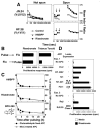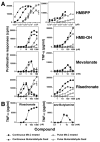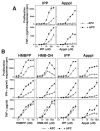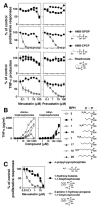Indirect stimulation of human Vγ2Vδ2 T cells through alterations in isoprenoid metabolism
- PMID: 22013129
- PMCID: PMC3326638
- DOI: 10.4049/jimmunol.1002697
Indirect stimulation of human Vγ2Vδ2 T cells through alterations in isoprenoid metabolism
Abstract
Human Vγ2Vδ2 T cells monitor isoprenoid metabolism by recognizing (E)-4-hydroxy-3-methyl-but-2-enyl pyrophosphate (HMBPP), an intermediate in the 2-C-methyl-d-erythritol-4-phosphate pathway used by microbes, and isopentenyl pyrophosphate (IPP), an intermediate in the mevalonate pathway used by humans. Aminobisphosphonates and alkylamines indirectly stimulate Vγ2Vδ2 cells by inhibiting farnesyl diphosphate synthase (FDPS) in the mevalonate pathway, thereby increasing IPP/triphosphoric acid 1-adenosin-5'-yl ester 3-(3-methylbut-3-enyl) ester that directly stimulate. In this study, we further characterize stimulation by these compounds and define pathways used by new classes of compounds. Consistent with FDPS inhibition, stimulation of Vγ2Vδ2 cells by aminobisphosphonates and alkylamines was much more sensitive to statin inhibition than stimulation by prenyl pyrophosphates; however, the continuous presence of aminobisphosphonates was toxic for T cells and blocked their proliferation. Aminobisphosphonate stimulation was rapid and prolonged, independent of known Ag-presenting molecules, and resistant to fixation. New classes of stimulatory compounds-mevalonate, the alcohol of HMBPP, and alkenyl phosphonates-likely stimulate differently. Mevalonate, a rate-limiting metabolite, appears to enter cells to increase IPP levels, whereas the alcohol of HMBPP and alkenyl phosphonates are directly recognized. The critical chemical feature of bisphosphonates is the amino moiety, because its loss switched aminobisphosphonates to direct Ags. Transfection of APCs with small interfering RNA downregulating FDPS rendered them stimulatory for Vγ2Vδ2 cells and increased cellular IPP. Small interfering RNAs for isopentenyl diphosphate isomerase functioned similarly. Our results show that a variety of manipulations affecting isoprenoid metabolism lead to stimulation of Vγ2Vδ2 T cells and that pulsing aminobisphosphonates would be more effective for the ex vivo expansion of Vγ2Vδ2 T cells for adoptive cancer immunotherapy.
Figures










Similar articles
-
Metabolic engineering of Salmonella vaccine bacteria to boost human Vγ2Vδ2 T cell immunity.J Immunol. 2014 Jul 15;193(2):708-21. doi: 10.4049/jimmunol.1302746. Epub 2014 Jun 18. J Immunol. 2014. PMID: 24943221 Free PMC article.
-
Preferential recognition of a microbial metabolite by human Vgamma2Vdelta2 T cells.Int Immunol. 2007 May;19(5):657-73. doi: 10.1093/intimm/dxm031. Epub 2007 Apr 19. Int Immunol. 2007. PMID: 17446209
-
Nonpeptide antigens, presentation mechanisms, and immunological memory of human Vgamma2Vdelta2 T cells: discriminating friend from foe through the recognition of prenyl pyrophosphate antigens.Immunol Rev. 2007 Feb;215:59-76. doi: 10.1111/j.1600-065X.2006.00479.x. Immunol Rev. 2007. PMID: 17291279 Review.
-
Expansion of human peripheral blood γδ T cells using zoledronate.J Vis Exp. 2011 Sep 9;(55):3182. doi: 10.3791/3182. J Vis Exp. 2011. PMID: 21931292 Free PMC article.
-
Small molecules for the activation of human gammadelta T cell responses against infection.Recent Pat Antiinfect Drug Discov. 2008 Jan;3(1):1-9. doi: 10.2174/157489108783413218. Recent Pat Antiinfect Drug Discov. 2008. PMID: 18221182 Review.
Cited by
-
Deregulated expression and activity of Farnesyl Diphosphate Synthase (FDPS) in Glioblastoma.Sci Rep. 2017 Oct 26;7(1):14123. doi: 10.1038/s41598-017-14495-6. Sci Rep. 2017. PMID: 29075041 Free PMC article.
-
Identification of foam cell biomarkers by microarray analysis.BMC Cardiovasc Disord. 2020 May 6;20(1):211. doi: 10.1186/s12872-020-01495-0. BMC Cardiovasc Disord. 2020. PMID: 32375652 Free PMC article.
-
The Use of Oral Amino-Bisphosphonates and Coronavirus Disease 2019 (COVID-19) Outcomes.J Bone Miner Res. 2021 Nov;36(11):2177-2183. doi: 10.1002/jbmr.4419. Epub 2021 Aug 22. J Bone Miner Res. 2021. PMID: 34405441 Free PMC article.
-
Metabolic and behavioral features of acute hyperpurinergia and the maternal immune activation mouse model of autism spectrum disorder.PLoS One. 2021 Mar 18;16(3):e0248771. doi: 10.1371/journal.pone.0248771. eCollection 2021. PLoS One. 2021. PMID: 33735311 Free PMC article.
-
Zoledronic acid-induced expansion of γδ T cells from early-stage breast cancer patients: effect of IL-18 on helper NK cells.Cancer Immunol Immunother. 2013 Apr;62(4):677-87. doi: 10.1007/s00262-012-1368-4. Epub 2012 Nov 15. Cancer Immunol Immunother. 2013. PMID: 23151944 Free PMC article.
References
-
- Morita CT, Jin C, Sarikonda G, Wang H. Nonpeptide antigens, presentation mechanisms, and immunological memory of human Vγ2Vδ2 T cells: discriminating friend from foe through the recognition of prenyl pyrophosphate antigens. Immunol Rev. 2007;215:59–76. - PubMed
-
- Wilhelm M, Kunzmann V, Eckstein S, Reimer P, Weissinger F, Ruediger T, Tony H-P. γδ T cells for immune therapy of patients with lymphoid malignancies. Blood. 2003;102:200–206. - PubMed
-
- Dieli F, Vermijlen D, Fulfaro F, Caccamo N, Meraviglia S, Cicero G, Roberts A, Buccheri S, D’Asaro M, Gebbia N, Salerno A, Eberl M, Hayday AC. Targeting human γδ T cells with zoledronate and interleukin-2 for immunotherapy of hormone-refractory prostate cancer. Cancer Res. 2007;67:7450–7457. - PMC - PubMed
Publication types
MeSH terms
Substances
Grants and funding
LinkOut - more resources
Full Text Sources
Other Literature Sources
Miscellaneous

